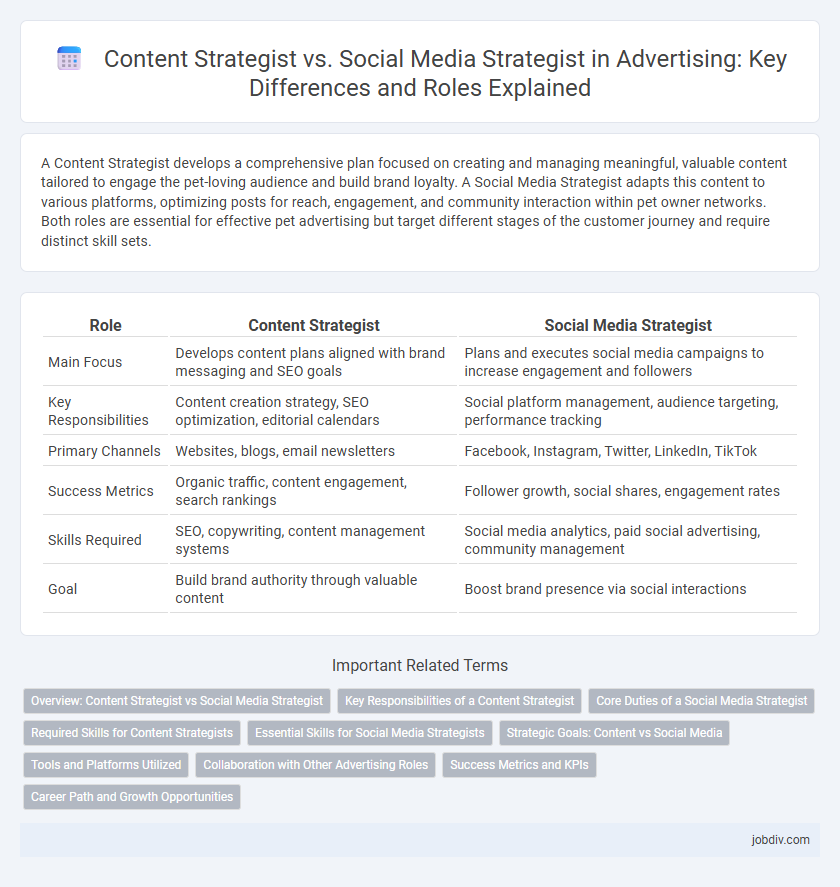A Content Strategist develops a comprehensive plan focused on creating and managing meaningful, valuable content tailored to engage the pet-loving audience and build brand loyalty. A Social Media Strategist adapts this content to various platforms, optimizing posts for reach, engagement, and community interaction within pet owner networks. Both roles are essential for effective pet advertising but target different stages of the customer journey and require distinct skill sets.
Table of Comparison
| Role | Content Strategist | Social Media Strategist |
|---|---|---|
| Main Focus | Develops content plans aligned with brand messaging and SEO goals | Plans and executes social media campaigns to increase engagement and followers |
| Key Responsibilities | Content creation strategy, SEO optimization, editorial calendars | Social platform management, audience targeting, performance tracking |
| Primary Channels | Websites, blogs, email newsletters | Facebook, Instagram, Twitter, LinkedIn, TikTok |
| Success Metrics | Organic traffic, content engagement, search rankings | Follower growth, social shares, engagement rates |
| Skills Required | SEO, copywriting, content management systems | Social media analytics, paid social advertising, community management |
| Goal | Build brand authority through valuable content | Boost brand presence via social interactions |
Overview: Content Strategist vs Social Media Strategist
Content Strategists develop comprehensive plans to create, publish, and manage content aligned with brand goals, focusing on SEO, audience engagement, and multi-channel storytelling. Social Media Strategists specialize in crafting targeted campaigns across platforms like Facebook, Instagram, and Twitter to increase brand awareness, drive traffic, and foster community interaction. Both roles require data analysis and trend monitoring but differ in scope, with Content Strategists overseeing broader content ecosystems and Social Media Strategists concentrating on social platform optimizations.
Key Responsibilities of a Content Strategist
A Content Strategist primarily develops and manages editorial schedules, ensuring all content aligns with brand messaging and business objectives. They conduct audience research and analyze content performance metrics to optimize engagement and drive conversions. Their role includes collaborating with designers and writers to create cohesive, relevant, and high-quality content across multiple platforms.
Core Duties of a Social Media Strategist
A Social Media Strategist specializes in developing and executing targeted campaigns across platforms like Facebook, Instagram, Twitter, and LinkedIn to increase brand awareness and engagement. Core duties include analyzing audience insights, monitoring social media trends, and optimizing content performance through data-driven strategies. Collaborating with marketing teams, they ensure consistent messaging that aligns with overall brand objectives and drives user interaction.
Required Skills for Content Strategists
Content Strategists require strong skills in audience analysis, SEO, and content planning to create targeted, engaging messaging across multiple platforms. Proficiency in data analytics and editorial calendar management enables effective content distribution and performance tracking. Mastery of storytelling techniques and cross-functional collaboration ensures content aligns with brand goals and drives customer engagement.
Essential Skills for Social Media Strategists
Social Media Strategists excel in skills like audience analysis, content scheduling, and platform-specific engagement strategies, which differ from the broader content planning focus of Content Strategists. Mastery of analytics tools such as Google Analytics, Hootsuite, and native social media insights enables Social Media Strategists to optimize campaigns and increase ROI. Expertise in real-time community management and trend adaptation is crucial for driving brand visibility and fostering user interaction across channels.
Strategic Goals: Content vs Social Media
Content Strategists prioritize creating comprehensive plans that align with broader brand objectives, focusing on producing valuable, relevant content to engage target audiences and drive conversions. Social Media Strategists concentrate on leveraging platform-specific tactics to increase brand visibility, foster community engagement, and optimize real-time interactions across social channels. Both roles work synergistically to enhance overall marketing effectiveness, but Content Strategists emphasize long-term storytelling while Social Media Strategists focus on agile, audience-responsive campaigns.
Tools and Platforms Utilized
Content Strategists leverage tools like Google Analytics, SEMrush, and content management systems (CMS) such as WordPress to optimize keyword targeting, audience segmentation, and editorial calendars. Social Media Strategists primarily use platforms like Hootsuite, Buffer, and native analytics tools on Facebook, Instagram, and LinkedIn to schedule posts, track engagement metrics, and manage ad campaigns. Both roles rely on data-driven insights but differ in platform specialization, with Content Strategists focusing on long-form content distribution and SEO, while Social Media Strategists emphasize real-time audience interaction and social listening tools.
Collaboration with Other Advertising Roles
Content Strategists and Social Media Strategists collaborate closely with copywriters, graphic designers, and media planners to ensure cohesive messaging across platforms. Content Strategists develop in-depth editorial calendars and SEO-driven content frameworks, while Social Media Strategists focus on real-time audience engagement and platform-specific trends. This synergy maximizes brand reach, leveraging data analytics and creative insights to optimize campaign performance and return on investment.
Success Metrics and KPIs
Content strategists measure success primarily through engagement metrics such as time on page, content shares, and conversion rates, emphasizing content quality and audience retention. Social media strategists focus on KPIs like follower growth, reach, engagement rate, and click-through rates to gauge brand visibility and community interaction. Both roles leverage data analytics tools to refine strategies, yet content strategists align KPIs with content performance while social media strategists prioritize platform-specific audience dynamics.
Career Path and Growth Opportunities
Content Strategists focus on developing comprehensive content plans that align with brand messaging and audience engagement across multiple platforms, positioning themselves for roles such as Content Director or Chief Content Officer. Social Media Strategists specialize in optimizing brand presence on social channels, leveraging analytics and trend insights to drive community growth, often advancing to Social Media Manager or Digital Marketing Director roles. Both careers boast significant growth opportunities fueled by expanding digital marketing demands and evolving consumer behavior trends.
Content Strategist vs Social Media Strategist Infographic

 jobdiv.com
jobdiv.com